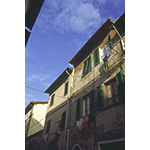Terranuova Bracciolini
Terranuova Bracciolini, a city founded by the Republic of Florence in 1337, is known for its exceptionally regular urban plan. Among the "new Florentine lands", it still conserves its original layout, as do San Giovanni and Castelfranco.
The "new Florentine lands" were founded or planned between 1299 and 1350, by the Republic of Florence, as a home for people from the surrounding countryside seeking freedom from their feudal lords. Six cities were originally planned: San Giovanni, Castelfranco and Terranuova in the upper Valdarno, Scarperia and Firenzuola in the Apennines area between Florence and Bologna, and Giglio Fiorentino, which was planned for a valley in the Arezzo territory, but was never built.
Terranuova Bracciolini was also known as Castel Santa Maria, a place name that was soon accompanied by that of Terra Nuova, which had become the official name already by the 15th century. The design of the city was entrusted to the "stronghold officials", who decided on the dimensions and form of the fortifications, the size of the roads, the location of the churches and the division into quarters. The populations of these towns, who had rebelled against the counts, were obliged to live in specific sections of the new centre, and had the duty of building a new church with the same dedication as the one they had abandoned.
In an exception to the rule that unbaked clay was used only for rural buildings in Tuscany, many adobe constructions are found even in the historic centre of Terranuova. It has been thought that the use of unbaked clay in such an important architectural episode depended on the need to finish building the houses within an established time, or that the commitment assumed by the population to destroy the old houses where they had lived before had led many to reutilize the same material for the new urban houses, even though it was only unbaked clay.
****************************
Texts by Giovanna Ranocchiai
English translation by Catherine Frost
Last update 29/dic/2010





